Endometriosis Solutions: Causes, Symptoms, Treatment Approaches and Lifestyle Management
Endometriosis Solutions: Causes, Symptoms, Treatment Approaches and Lifestyle Management
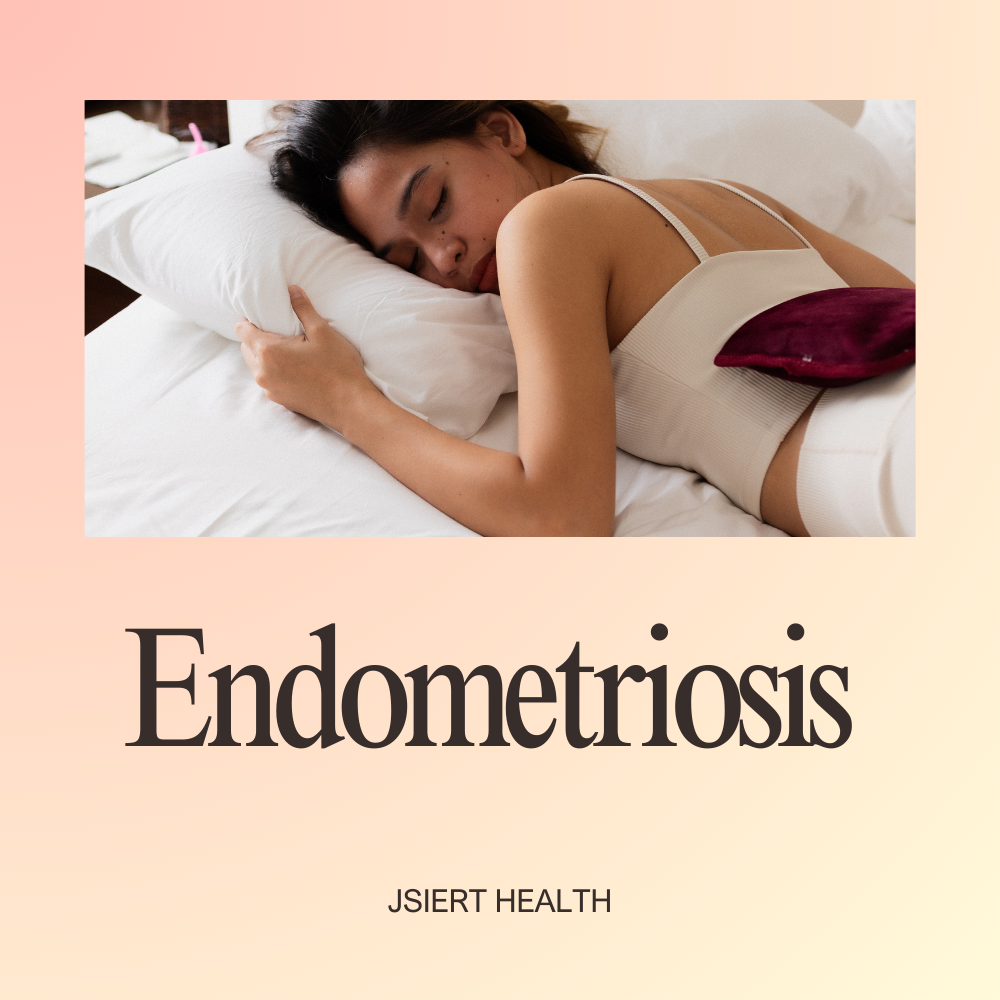
Introduction to Endometriosis
Endometriosis is a complex and often debilitating gynecological condition that affects millions of women worldwide. This section provides a comprehensive overview of endometriosis, including its definition, prevalence, and impact on women’s health.
Definition and Overview:
Endometriosis is a chronic condition characterized by the growth of endometrial-like tissue outside the uterus. Normally, the endometrium, the tissue that lines the inside of the uterus, thickens each month in preparation for pregnancy. If pregnancy does not occur, this tissue is shed during menstruation. However, in endometriosis, this tissue grows outside the uterus, typically in the pelvic region but sometimes in other areas of the body.
The misplaced endometrial tissue responds to hormonal changes in the menstrual cycle in the same way as the tissue lining the uterus. This means it thickens, breaks down, and bleeds during menstruation, but because it has no way to exit the body, it becomes trapped. This can lead to inflammation, scarring, and the formation of adhesions (abnormal tissue connections) between organs, causing pain and other symptoms.
Prevalence and Impact on Women’s Health:
Endometriosis is a prevalent condition, affecting an estimated 10% of women of reproductive age worldwide. However, due to underdiagnosis and misdiagnosis, the true prevalence may be higher.
The impact of endometriosis on women’s health can be profound. It is a leading cause of chronic pelvic pain, which can significantly impair quality of life and interfere with daily activities. Additionally, endometriosis is associated with various reproductive health issues, including infertility and menstrual irregularities. The condition can also have a substantial emotional and psychological impact, leading to feelings of frustration, isolation, and depression in many individuals.
Furthermore, the economic burden of endometriosis is substantial, both for affected individuals and healthcare systems. The costs associated with medical consultations, diagnostic tests, treatments, and lost productivity due to symptoms and disability contribute to the overall burden of the disease.
Understanding the Causes of Endometriosis
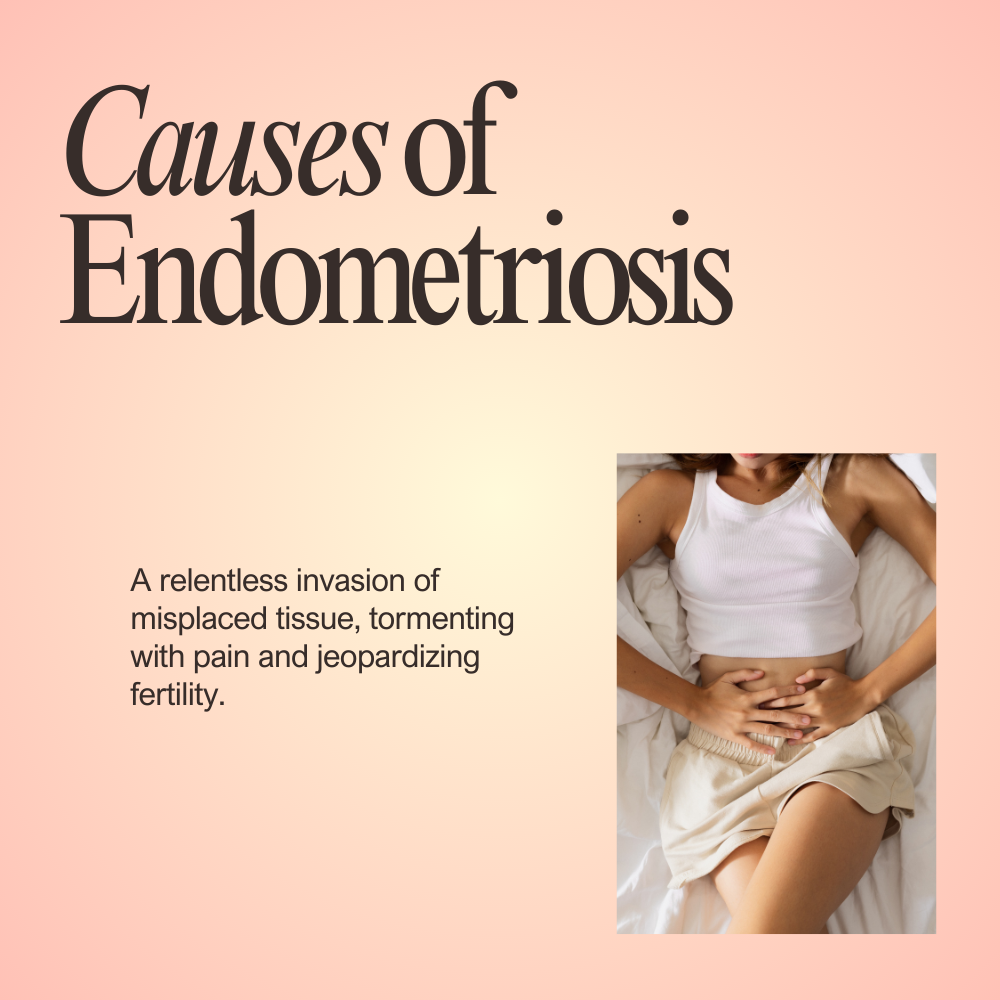
Endometriosis is a multifactorial condition with its exact cause not yet fully understood. However, several theories have been proposed to explain its development. This section explores the potential causes of endometriosis, including the retrograde menstruation theory, hormonal imbalance, genetic factors, and immune system dysfunction.
- Retrograde Menstruation Theory:
- According to the retrograde menstruation theory, during menstruation, some of the menstrual blood containing endometrial cells flows backward through the fallopian tubes into the pelvic cavity instead of exiting the body through the vagina. These endometrial cells then implant and grow on the pelvic organs, such as the ovaries, fallopian tubes, and pelvic lining, leading to the development of endometriosis.
- While retrograde menstruation occurs in many women, not all develop endometriosis, suggesting that other factors may contribute to its development.
- Hormonal Imbalance:
- Hormonal factors, particularly estrogen, play a crucial role in the development and progression of endometriosis. Estrogen stimulates the growth and proliferation of endometrial tissue.
- In women with endometriosis, there is evidence of altered estrogen metabolism and responsiveness, leading to increased estrogen levels within the pelvic cavity.
- Additionally, other hormones, such as progesterone and testosterone, may also influence the development of endometriosis by affecting the growth and survival of endometrial cells.
- Genetic Factors:
- Genetic predisposition is believed to contribute to the development of endometriosis. Studies have shown that women with a family history of endometriosis are at an increased risk of developing the condition.
- Various genetic factors, including gene mutations and polymorphisms, may influence susceptibility to endometriosis. These genetic variations may affect hormonal regulation, immune response, and tissue inflammation, all of which are implicated in the pathogenesis of endometriosis.
- Immune System Dysfunction:
- Dysregulation of the immune system is thought to play a significant role in the development of endometriosis. Normally, the immune system helps recognize and eliminate abnormal or foreign cells, including endometrial cells that escape into the pelvic cavity.
- In women with endometriosis, there is evidence of immune dysfunction, including impaired immune surveillance and increased inflammation within the pelvic cavity.
- Abnormalities in immune cells, cytokines, and other immune-related factors may contribute to the survival, implantation, and growth of ectopic endometrial tissue, leading to the development and progression of endometriosis.
Common Symptoms of Endometriosis
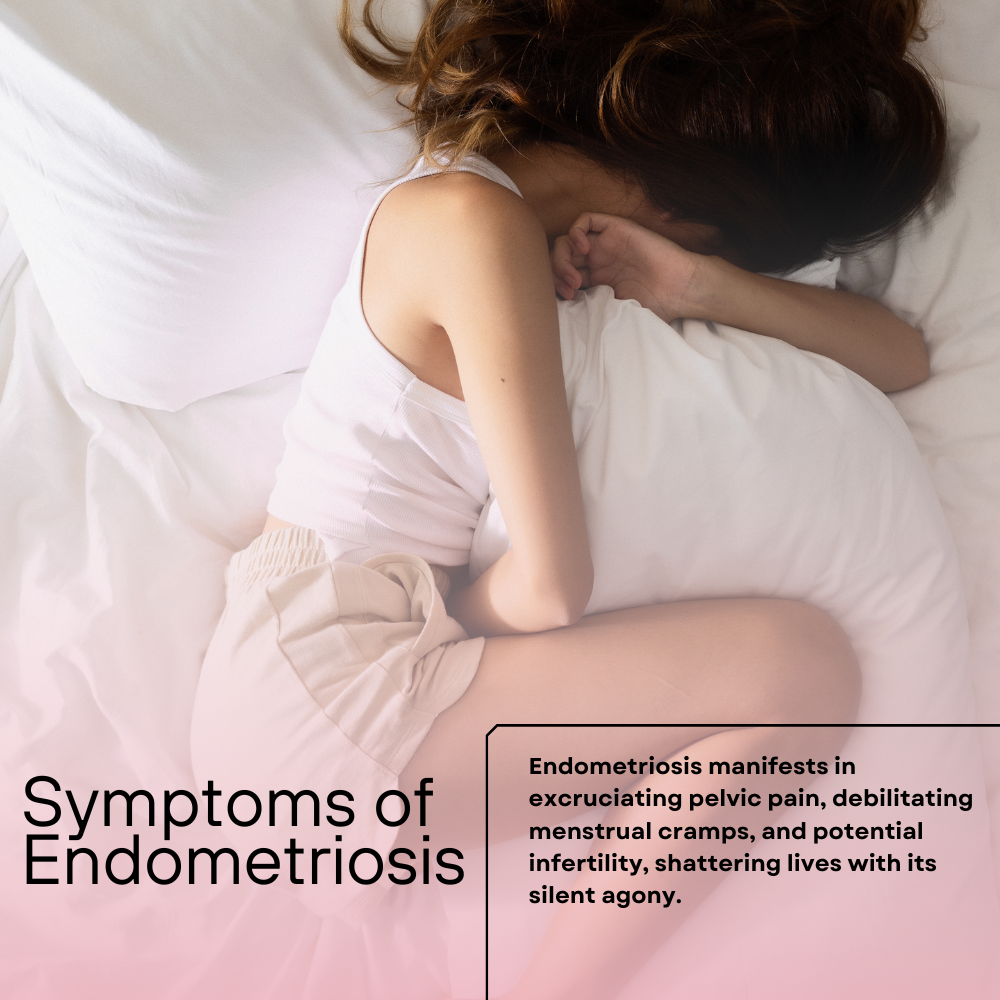
Endometriosis can manifest with a variety of symptoms, which can vary in severity and frequency among individuals. Recognizing these symptoms is crucial for early diagnosis and effective management. This section explores the common symptoms of endometriosis, including pelvic pain, menstrual irregularities, infertility, and other associated symptoms.
- Pelvic Pain:
- Pelvic pain is one of the hallmark symptoms of endometriosis and often the most debilitating. It typically presents as:
- Chronic pelvic pain: Persistent, dull, aching pain in the pelvis, lower abdomen, or lower back that may worsen during menstruation or sexual activity.
- Dysmenorrhea: Severe menstrual cramps that may begin several days before menstruation and persist throughout the menstrual period.
- Dyspareunia: Pain during or after sexual intercourse, often localized to the pelvis or deep within the abdomen.
- The intensity and duration of pelvic pain can vary widely among individuals, ranging from mild discomfort to severe, disabling pain that interferes with daily activities.
- Pelvic pain is one of the hallmark symptoms of endometriosis and often the most debilitating. It typically presents as:
- Menstrual Irregularities:
- Endometriosis can cause various menstrual irregularities, including:
- Heavy menstrual bleeding (menorrhagia)
- Irregular menstrual cycles
- Prolonged menstrual periods
- Spotting or bleeding between periods (intermenstrual bleeding)
- These irregularities may result from hormonal imbalances and abnormalities in the endometrial tissue outside the uterus.
- Endometriosis can cause various menstrual irregularities, including:
- Infertility:
- Endometriosis is a common cause of infertility in women. It can affect fertility through several mechanisms, including:
- Distortion or blockage of the fallopian tubes due to scar tissue or adhesions.
- Impaired ovarian function or ovulatory dysfunction.
- Altered endometrial receptivity for embryo implantation.
- While not all women with endometriosis experience infertility, the condition is more prevalent among women seeking fertility treatment.
- Endometriosis is a common cause of infertility in women. It can affect fertility through several mechanisms, including:
- Other Associated Symptoms:
- Endometriosis can be associated with a range of additional symptoms, including:
- Gastrointestinal symptoms: Bloating, diarrhea, constipation, abdominal cramping, and rectal pain, particularly during menstruation.
- Urinary symptoms: Urinary urgency, frequency, pain or discomfort during urination, and blood in the urine.
- Fatigue: Persistent tiredness or exhaustion, which may be exacerbated by chronic pain and sleep disturbances.
- Psychological symptoms: Anxiety, depression, mood swings, and decreased quality of life due to the chronic nature of the condition and its impact on daily functioning.
- Endometriosis can be associated with a range of additional symptoms, including:
Diagnosis of Endometriosis
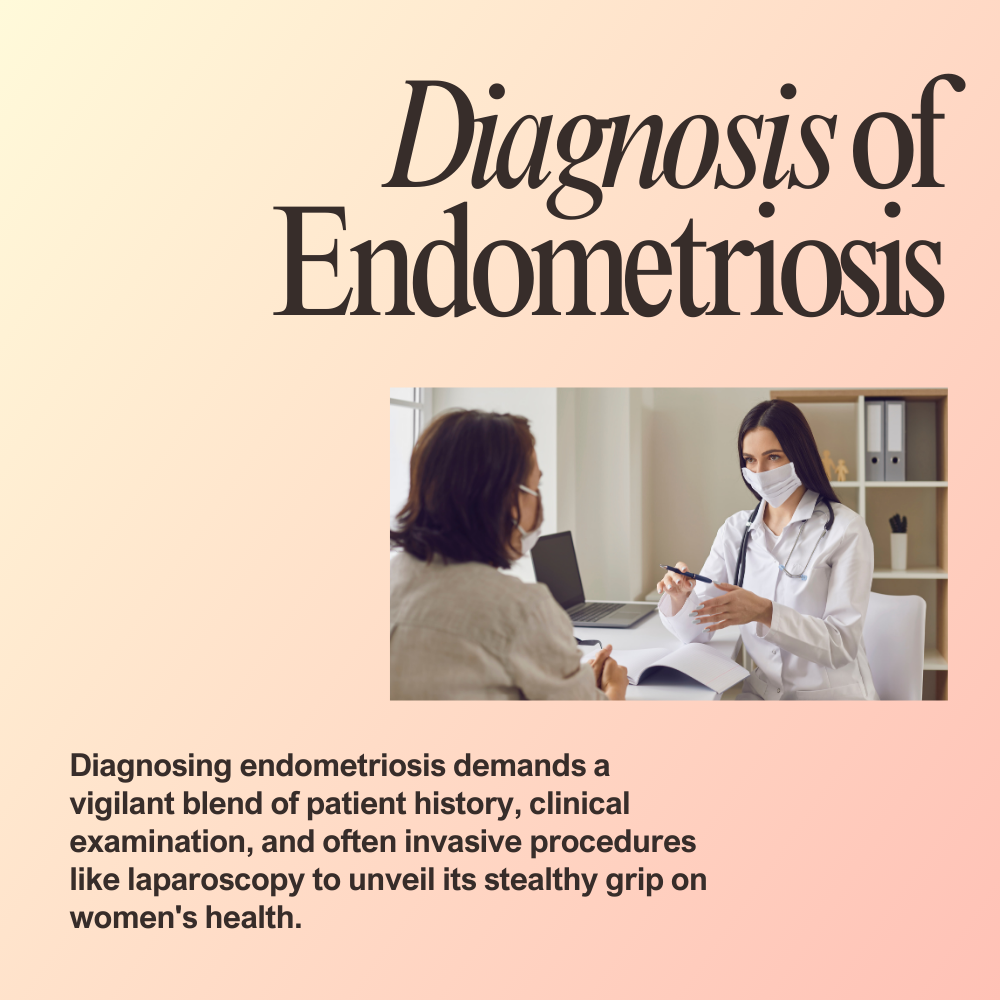
Accurate diagnosis of endometriosis is essential for initiating appropriate treatment and management strategies. This section outlines the diagnostic methods commonly used to identify endometriosis, including medical history and physical examination, imaging tests such as ultrasound and MRI, and laparoscopy, considered the gold standard for diagnosis.
- Medical History and Physical Examination:
- A detailed medical history and physical examination are the initial steps in the diagnostic process for endometriosis.
- Healthcare providers will inquire about the patient’s symptoms, including the nature, duration, and severity of pelvic pain, menstrual irregularities, and other associated symptoms.
- Physical examination may reveal signs suggestive of endometriosis, such as tender pelvic areas, palpable masses or nodules, and signs of pelvic inflammation.
- Imaging Tests: Ultrasound and MRI:
- Imaging tests such as pelvic ultrasound and magnetic resonance imaging (MRI) may be used to detect and evaluate endometriotic lesions and associated pelvic abnormalities.
- Transvaginal ultrasound (TVUS) is a commonly used imaging modality that uses sound waves to create images of the pelvic organs. It can identify endometriomas (cysts containing endometrial tissue) and detect pelvic adhesions.
- MRI provides detailed images of pelvic structures and can help visualize deep infiltrating endometriosis (DIE), which involves penetration of endometrial tissue into surrounding organs and tissues.
- Laparoscopy: Gold Standard for Diagnosis:
- Laparoscopy is the gold standard diagnostic procedure for endometriosis and is often performed when other diagnostic methods are inconclusive or when surgical intervention is warranted.
- During laparoscopy, a thin, flexible tube with a camera (laparoscope) is inserted through small incisions in the abdomen to visualize the pelvic organs and identify endometriotic lesions.
- Endometrial biopsies or tissue samples may be obtained during laparoscopy for histological examination to confirm the presence of endometriosis and assess its severity and extent.
Treatment Approaches for Endometriosis
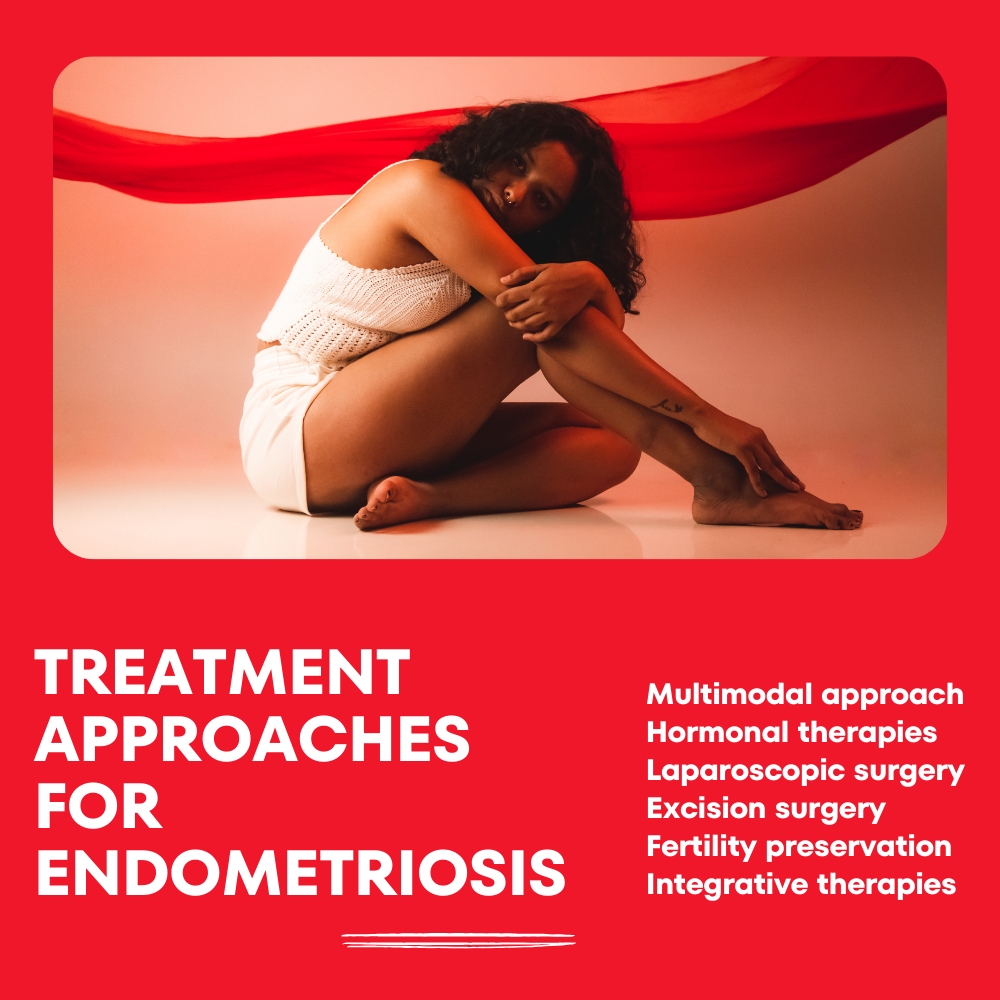
Effective management of endometriosis aims to alleviate symptoms, improve quality of life, and minimize disease progression. This section outlines various treatment approaches for endometriosis, including pain management strategies, hormonal and non-hormonal medications, surgical options, and alternative therapies.
- Pain Management Strategies:
- Pain management is a cornerstone of endometriosis treatment and often involves a combination of approaches to address both acute and chronic pain.
- Pain relief strategies may include:
- Heat therapy: Applying heat to the lower abdomen or pelvic area can help alleviate cramping and discomfort.
- Relaxation techniques: Techniques such as deep breathing, meditation, and guided imagery can help reduce stress and manage pain.
- Physical therapy: Pelvic floor exercises and stretches prescribed by a physical therapist can help relieve pelvic pain and improve pelvic muscle function.
- Over-the-Counter Pain Relievers:
- Over-the-counter (OTC) pain relievers, such as nonsteroidal anti-inflammatory drugs (NSAIDs) like ibuprofen or naproxen, can help reduce menstrual cramps and pelvic pain associated with endometriosis.
- These medications work by decreasing inflammation and prostaglandin production, which are involved in pain signaling.
- Hormonal Therapies:
- Hormonal therapies aim to suppress ovarian function and reduce estrogen levels, thereby inhibiting the growth of endometrial tissue and alleviating symptoms.
- Common hormonal therapies include:
- Birth control pills: Oral contraceptives containing estrogen and progestin can help regulate the menstrual cycle and reduce pain associated with endometriosis.
- Gonadotropin-releasing hormone (GnRH) agonists: These medications suppress ovarian function and induce a temporary menopause-like state, relieving symptoms of endometriosis.
- Non-Hormonal Medications:
- Non-hormonal medications, such as NSAIDs, can provide symptomatic relief by reducing inflammation and pain associated with endometriosis.
- NSAIDs are often used as first-line treatment for mild to moderate pelvic pain and menstrual cramps.
- Surgical Options:
- Surgical intervention may be necessary for individuals with severe or refractory endometriosis who do not respond adequately to conservative treatments.
- Surgical options include:
- Laparoscopic surgery: Minimally invasive surgery performed through small incisions in the abdomen to remove endometrial lesions, adhesions, and scar tissue.
- Hysterectomy: Removal of the uterus, with or without removal of the ovaries, may be considered in severe cases of endometriosis that do not respond to other treatments.
- Alternative Therapies:
- Alternative therapies, such as acupuncture, physical therapy, and dietary changes, may complement conventional treatments and help manage symptoms of endometriosis.
- Acupuncture may help alleviate pelvic pain and improve overall well-being by promoting relaxation and reducing stress.
- Physical therapy techniques, including pelvic floor exercises and stretches, can help improve pelvic muscle function and reduce pain.
- Dietary changes, such as adopting an anti-inflammatory diet rich in fruits, vegetables, whole grains, and omega-3 fatty acids, may help reduce inflammation and alleviate symptoms.
Lifestyle Management Tips for Endometriosis
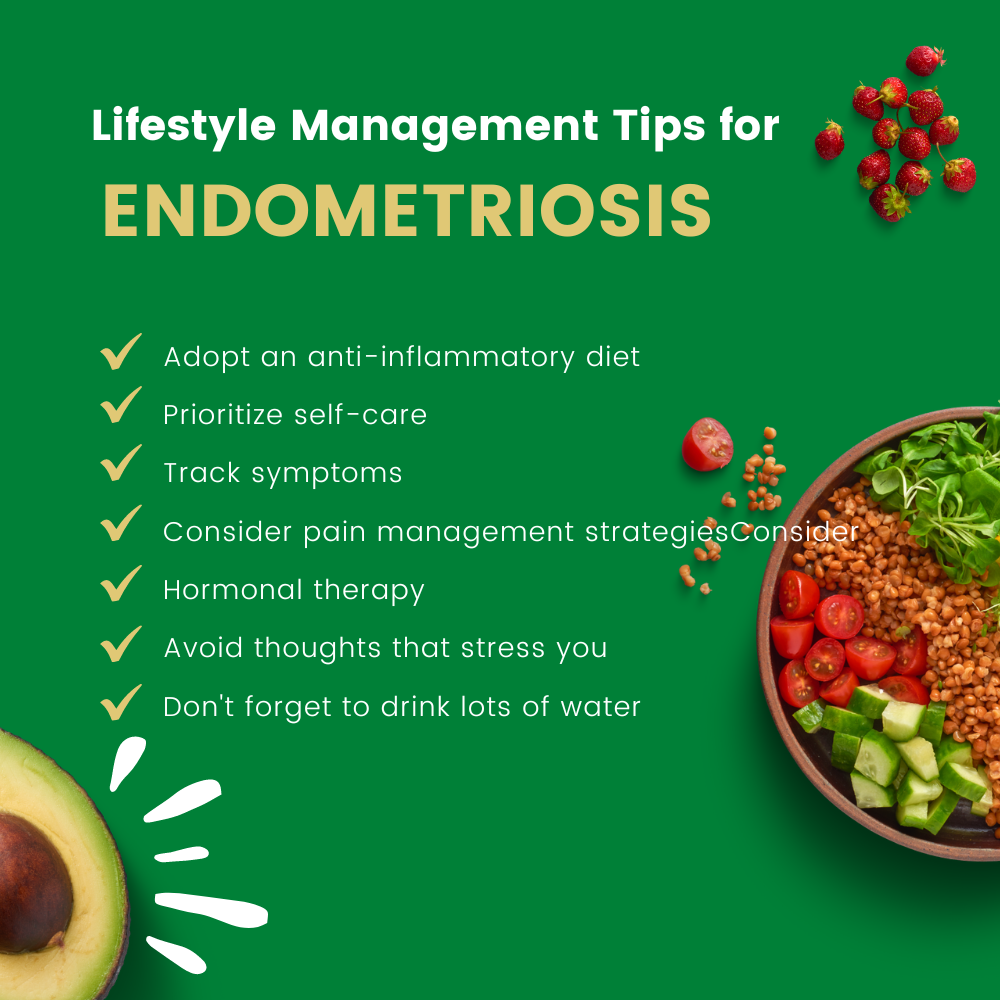
In addition to medical treatment, lifestyle modifications can play a crucial role in managing symptoms and improving quality of life for individuals with endometriosis. This section outlines various lifestyle management tips, including diet and nutrition recommendations, exercise and physical activity, stress management techniques, and sleep hygiene practices.
- Diet and Nutrition Recommendations:
- Incorporate a variety of fruits, vegetables, whole grains, lean proteins, and healthy fats into your diet to ensure you’re getting a balance of essential nutrients.
- Choose anti-inflammatory foods such as berries, leafy greens, fatty fish (like salmon and mackerel), nuts, seeds, and olive oil, which may help reduce inflammation and alleviate pain.
- Avoid trigger foods that may exacerbate symptoms, such as caffeine, alcohol, high-fat foods, processed foods, and foods high in sugar and sodium.
- Consider keeping a food diary to track your symptoms and identify any specific foods that may worsen your symptoms.
- Exercise and Physical Activity:
- Aim for at least 30 minutes of moderate-intensity exercise most days of the week, or as tolerated. If you’re new to exercise, start slowly and gradually increase the duration and intensity over time.
- Low-impact exercises like walking, swimming, cycling, and yoga are gentle on the body and can help improve cardiovascular health, muscle strength, and flexibility without exacerbating pelvic pain.
- Incorporate pelvic floor exercises (Kegels) into your routine to strengthen the muscles that support the pelvic organs and improve bladder and bowel function.
- Listen to your body and adjust your exercise routine as needed based on your symptoms. If you experience increased pain or discomfort during exercise, take a break and try a different activity.
- Stress Management Techniques:
- Practice mindfulness meditation regularly to cultivate awareness of your thoughts, emotions, and bodily sensations, and develop skills for managing stress and anxiety.
- Engage in relaxation exercises such as deep breathing, progressive muscle relaxation, and guided imagery to promote relaxation and reduce tension in the body.
- Consider seeking professional counseling or therapy to explore and address any underlying emotional issues related to your condition and develop coping strategies to manage stress more effectively.
- Connect with others who understand what you’re going through by joining support groups, either in person or online, where you can share experiences, offer support, and receive encouragement from others who are dealing with similar challenges.
- Sleep Hygiene Practices:
- Establish a consistent sleep schedule by going to bed and waking up at the same time each day, even on weekends.
- Create a relaxing bedtime routine to signal to your body that it’s time to wind down. This may include activities such as reading, taking a warm bath, or practicing relaxation techniques.
- Create a sleep-friendly environment by keeping your bedroom cool, dark, and quiet, and investing in a comfortable mattress and pillows that support your body and promote restful sleep.
- Limit exposure to screens (phones, tablets, computers, TVs) before bedtime, as the blue light emitted by these devices can interfere with your body’s natural sleep-wake cycle and make it harder to fall asleep.
- If you’re experiencing sleep disturbances such as insomnia or sleep apnea, talk to your healthcare provider about potential treatment options and lifestyle modifications to improve sleep quality.
Integrative Approaches to Endometriosis Management
In addition to conventional medical treatments, integrative approaches to endometriosis management focus on addressing the whole person—physically, emotionally, and spiritually. This section explores various integrative strategies, including collaboration with healthcare providers, self-care and advocacy, holistic wellness strategies, and addressing mental health needs.
- Collaboration with Healthcare Providers:
- Establishing a collaborative relationship with a multidisciplinary team of healthcare providers is essential for comprehensive endometriosis management.
- Work closely with gynecologists, pelvic pain specialists, nutritionists, physical therapists, mental health professionals, and other specialists to develop a personalized treatment plan tailored to your unique needs and preferences.
- Communicate openly with your healthcare team about your symptoms, treatment goals, and preferences, and actively participate in shared decision-making regarding your care.
- Importance of Self-Care and Advocacy:
- Engage in self-care practices to nurture your physical, emotional, and spiritual well-being and empower yourself to take an active role in managing your endometriosis.
- Advocate for yourself by seeking out information, resources, and support networks, and advocating for your needs within the healthcare system.
- Educate yourself about your condition, treatment options, and self-management strategies, and be proactive in seeking out alternative and complementary therapies that align with your values and goals.
- Holistic Wellness Strategies:
- Embrace holistic wellness strategies that encompass mind, body, and spirit to promote overall health and well-being.
- Practice mindfulness-based techniques such as meditation, yoga, tai chi, and qigong to cultivate relaxation, reduce stress, and enhance resilience.
- Explore complementary therapies such as acupuncture, massage therapy, chiropractic care, and herbal medicine to complement conventional treatments and alleviate symptoms.
- Prioritize self-care activities that bring you joy and fulfillment, whether it’s spending time in nature, engaging in creative pursuits, or connecting with loved ones.
- Addressing Mental Health Needs:
- Recognize the impact of endometriosis on mental health and emotional well-being, and seek support to address any psychological challenges or concerns.
- Be open and honest with your healthcare providers about any symptoms of depression, anxiety, or other mental health issues you may be experiencing, and seek appropriate treatment and support.
- Participate in individual or group therapy, counseling, or support groups to explore coping strategies, develop resilience, and connect with others who understand your experiences.
- Practice self-compassion and self-acceptance, and cultivate a sense of resilience and hope in the face of challenges posed by endometriosis.
By embracing integrative approaches to endometriosis management, you can take a holistic approach to your health and well-being, addressing not only the physical symptoms of the condition but also the emotional, social, and spiritual aspects. By collaborating with healthcare providers, prioritizing self-care and advocacy, embracing holistic wellness strategies, and addressing mental health needs, you can cultivate resilience, enhance your quality of life, and live well with endometriosis.
Support Resources for Individuals with Endometriosis
Living with endometriosis can be challenging, but you don’t have to face it alone. There are numerous support resources available to provide information, guidance, and emotional support. This section highlights various support resources, including endometriosis support groups, online communities and forums, and educational websites and books.
- Endometriosis Support Groups:
- Joining an endometriosis support group can provide valuable peer support, practical advice, and a sense of community with others who understand what you’re going through.
- Look for local support groups in your area through hospitals, clinics, or community organizations. These groups may meet in person or virtually and offer opportunities to connect with others face-to-face or through online platforms.
- National and international organizations dedicated to endometriosis, such as the Endometriosis Association or the Endometriosis Research Center, may also offer resources and support group listings on their websites.
- Online Communities and Forums:
- Online communities and forums provide a platform for individuals with endometriosis to connect, share experiences, and offer support to one another.
- Websites such as Inspire, Reddit (r/Endo), and HealthUnlocked host discussion forums where individuals can ask questions, share stories, and exchange information about living with endometriosis.
- Social media platforms like Facebook, Instagram, and Twitter also host groups and pages dedicated to endometriosis awareness and support.
- Educational Websites and Books:
- Educational websites and books offer valuable information about endometriosis, its symptoms, treatment options, and self-management strategies.
- Websites such as the Endometriosis Foundation of America, the Endometriosis UK, and the Endometriosis Research Center provide comprehensive resources, articles, and fact sheets about endometriosis.
- Books written by healthcare professionals, patient advocates, and individuals with endometriosis offer insights, guidance, and practical tips for living well with the condition. Some recommended titles include “The Endometriosis Health and Diet Program” by Dr. Andrew S. Cook and “The Doctor Will See You Now: Recognizing and Treating Endometriosis” by Dr. Tamer Seckin.
Whether you’re seeking emotional support, practical advice, or reliable information about endometriosis, these support resources can be invaluable tools in your journey. Remember that every individual’s experience with endometriosis is unique, so explore different resources to find what works best for you and your needs.
Future Directions in Endometriosis Research and Treatment
Endometriosis research and treatment continue to evolve, with ongoing efforts aimed at improving outcomes and quality of life for individuals with the condition. This section explores future directions in endometriosis research and treatment, including emerging therapies and treatment modalities, advancements in early detection and prevention strategies, and promising areas of research.
- Emerging Therapies and Treatment Modalities:
- Researchers are exploring novel therapeutic approaches to endometriosis management, including:
- Targeted molecular therapies: Investigating drugs that target specific molecular pathways involved in endometriosis development and progression, such as angiogenesis inhibitors, hormone receptor modulators, and immunomodulators.
- Stem cell therapy: Exploring the potential of stem cell-based therapies to regenerate damaged tissues and restore normal function in individuals with endometriosis.
- Gene therapy: Investigating gene editing techniques and gene expression modulation to target genetic factors implicated in endometriosis susceptibility and pathogenesis.
- Non-pharmacological interventions: Evaluating the efficacy of non-pharmacological treatments such as nerve stimulation, acupuncture, and physical therapy in managing endometriosis-related pain and symptoms.
- Researchers are exploring novel therapeutic approaches to endometriosis management, including:
- Advancements in Early Detection and Prevention Strategies:
- Researchers are working to develop improved methods for early detection and risk stratification of endometriosis, which may lead to earlier diagnosis and intervention.
- Advances in imaging technology, such as high-resolution ultrasound, magnetic resonance imaging (MRI), and molecular imaging techniques, may enable more accurate and non-invasive diagnosis of endometriosis lesions.
- Biomarker discovery and validation efforts aim to identify reliable blood-based or tissue-based markers that can aid in the early detection, monitoring, and personalized treatment of endometriosis.
- Promising Areas of Research:
- Current research efforts are focused on elucidating the underlying mechanisms of endometriosis pathogenesis and identifying new therapeutic targets.
- Immunological dysregulation, inflammatory signaling pathways, epigenetic modifications, and microbiome dysbiosis are among the key areas of interest in endometriosis research.
- Collaborative research initiatives and multi-center clinical trials are underway to investigate the effectiveness of new drugs, combination therapies, and personalized treatment approaches in managing endometriosis and its associated symptoms.
Conclusion: Empowering Individuals with Endometriosis
Empowering individuals with endometriosis involves raising awareness, promoting early diagnosis and intervention, and providing comprehensive support and resources for managing the condition. By encouraging individuals to seek timely diagnosis and treatment, emphasizing the importance of a comprehensive management approach, and fostering hope for improved quality of life and well-being, we can support individuals with endometriosis on their journey toward better health and wellness. With ongoing research advancements and collaborative efforts, there is hope for better outcomes and brighter futures for individuals living with endometriosis.
REFERENCES
When referencing a comprehensive guide like “Endometriosis Solutions: Causes, Symptoms, Treatment Approaches, and Lifestyle Management,” it’s crucial to consider the sources from which the information was gathered. Here’s a list of potential references that could be included:
- Medical journals and research articles:
- Researchers and clinicians often publish findings related to endometriosis in reputable medical journals such as The New England Journal of Medicine, The Lancet, Obstetrics & Gynecology, and Fertility and Sterility.
- Examples of specific articles may include studies on the pathophysiology of endometriosis, clinical trials evaluating treatment modalities, and reviews of lifestyle management strategies.
- Clinical guidelines and consensus statements:
- Guidelines and consensus statements developed by professional medical organizations provide evidence-based recommendations for the diagnosis and management of endometriosis.
- For instance, guidelines from organizations like the American College of Obstetricians and Gynecologists (ACOG), the European Society of Human Reproduction and Embryology (ESHRE), and the World Endometriosis Society (WES) offer valuable insights into best practices for endometriosis care.
- Books authored by experts in the field:
- Books written by healthcare professionals specializing in endometriosis can serve as valuable references for comprehensive information on the condition.
- Authors such as Dr. Andrew S. Cook, Dr. Tamer Seckin, and Dr. David B. Redwine have written extensively on endometriosis diagnosis, treatment, and lifestyle management.
- Government health agencies and educational websites:
- Websites maintained by government health agencies such as the National Institutes of Health (NIH) and the Centers for Disease Control and Prevention (CDC) often provide reliable information on endometriosis.
- Educational resources from reputable institutions like Mayo Clinic, Cleveland Clinic, and Harvard Medical School may also offer valuable insights into endometriosis management.
- Patient advocacy organizations and support groups:
- Non-profit organizations dedicated to endometriosis advocacy and support, such as the Endometriosis Foundation of America (EndoFound) and the Endometriosis Association, can provide valuable resources and information for individuals seeking guidance on managing the condition.
- Additionally, online support groups and forums may offer anecdotal insights and peer support for individuals living with endometriosis.
When referencing “Endometriosis Solutions: Causes, Symptoms, Treatment Approaches, and Lifestyle Management,” it’s important to cite specific sources from which the information was derived, providing readers with transparency and credibility.
FAQ (Frequently Asked Questions) for “Endometriosis Solutions: Causes, Symptoms, Treatment Approaches, and Lifestyle Management” can be highly beneficial for providing concise answers to common queries about the condition and its management. Here’s a sample FAQ:
- What is endometriosis?
- Endometriosis is a chronic condition where tissue similar to the lining of the uterus (endometrium) grows outside the uterus, leading to inflammation, scarring, and pain.
- What are the main causes of endometriosis?
- The exact cause of endometriosis is unknown, but potential factors include retrograde menstruation, hormonal imbalance, genetic predisposition, and immune system dysfunction.
- What are the symptoms of endometriosis?
- Common symptoms of endometriosis include pelvic pain, menstrual irregularities, infertility, painful intercourse, fatigue, and gastrointestinal issues such as bloating and diarrhea.
- How is endometriosis diagnosed?
- Diagnosis often involves a combination of medical history assessment, pelvic examination, imaging tests (ultrasound, MRI), and laparoscopy—a minimally invasive surgical procedure to visualize and biopsy endometrial tissue.
- What are the treatment approaches for endometriosis?
- Treatment options include pain management strategies, hormonal therapies (e.g., birth control pills, GnRH agonists), non-hormonal medications (e.g., NSAIDs), surgical options (e.g., laparoscopic excision), and alternative therapies (e.g., acupuncture, physical therapy).
- Can lifestyle changes help manage endometriosis?
- Yes, adopting healthy lifestyle habits such as following an anti-inflammatory diet, engaging in regular exercise, practicing stress management techniques, and prioritizing adequate sleep can help alleviate symptoms and improve overall well-being.
- Are there support resources available for individuals with endometriosis?
- Yes, there are various support resources including endometriosis support groups, online communities and forums, educational websites, and books authored by experts in the field.
- What are some promising areas of research in endometriosis?
- Promising areas of research include investigating targeted molecular therapies, advancements in early detection and prevention strategies, and understanding the role of immunological dysregulation and inflammatory pathways in endometriosis pathogenesis.
- How can individuals empower themselves in managing endometriosis?
- Empowering individuals with endometriosis involves seeking timely diagnosis and treatment, adopting a comprehensive management approach, and fostering hope for improved quality of life and well-being.
- Where can I find more information about endometriosis?
- Refer to reputable sources such as medical journals, clinical guidelines, books authored by experts, government health agencies, patient advocacy organizations, and support groups for comprehensive information and support.
Tailoring the FAQ to address specific concerns and questions commonly asked by individuals with endometriosis can enhance its relevance and usefulness as a resource for education and supports.